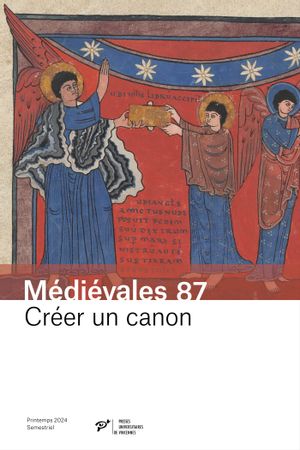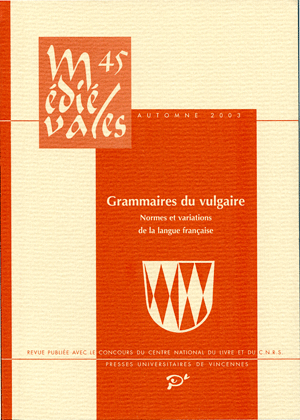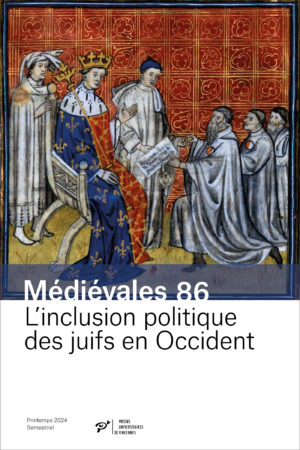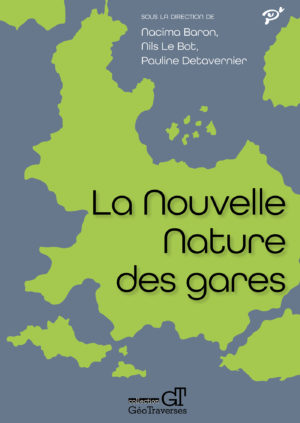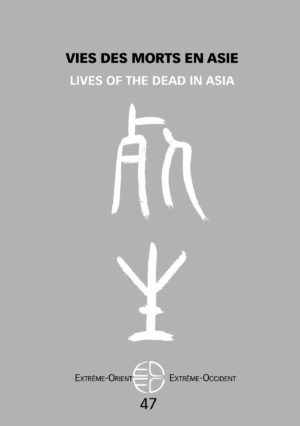Roger Wright : « The Period of Transition between Latin, Lingua romana and French »
The living language which was still called lingua latina in the eighth century A.D. was thought of then as being one single language despite wide social and geographical variation. But it had split into several languages by the end of the thirteenth century : French, Provenzal, Catalan, Castilian, Portuguese, Italian, etc., as well as the ” dead ” language we know of as Medieval Latin. The initial stage in this process came in the Carolingian realms during the ninth century, when for the first time some people made a systematic distinction between Latin (standardized grammatica, what we would call Medieval Latin) and Romance. This kind of Latin was standardized in writing according to the rules of Donatus and Priscian, and in speech according to the procedures of the Germanic-speaking scholars who were used to pronouncing all words as if reading them aloud, with a specified sound for each written letter. The Romance half of the incipient dichotomy combined the spoken register with a new written form, initially based (e.g. in the Cantilène de sainte Eulalie) on providing a written symbol for each spoken sound roughly according to the correspondences between letter and sound that had been established by the Carolingian reformers for Medieval Latin. This new written Romance form was essentially an experimental way of writing before the eleventh century ; after that, different Romance-speaking areas needed to spell words in different ways, and the idea that there were several Romance languages rather than one became generally accepted. Thus the transitions are a question both of language change and of change of the language’s name, and the latter is as much a question of politics as it is of linguistics.
Cantilène de sainte Eulalie – late Latin – Romance – Serments de Strasbourg &emdash; sociolinguistics
Michel Banniard : « Latinophones, Romanophones, Germanophones : Identity Interactions and Linguistical Constructions (8th-10th Century) »
The study of the genesis of Romance literature reveals that the langue d’oïl benefited from a considerable chronological advance compared to the other languages of the Latin Occident. The present study, carried out in the perspective of diachronic sociolinguistics, insists on the stimulating role played by the Austrasian region in bringing about this difference. The promotion of the Germanic speech to the rank of a literary language, thanks to the efforts of Germanophone intellectuals who, under the effect of various interactions such as rivalry or imitation, responded to the demands of the eastern elite, brought about the desire for an identical consecration for the Romance speech, hitherto excluded from this creative level to the advantage of Latin. The first literary monuments (9th-10th centuries) responded to this demand by consecrating everyday speech, not so much as being the language of the people but as the language of the elite.
Austrasia – Late Latin – Old French – Old German – sociolinguistics
David Trotter : « Anglo-Norman : Insular or Isolated ? »
Tradition would have it that Anglo-Norman (especially later Anglo-Norman) is an isolated variety of medieval French, which explains some of its peculiarities. With the ” loss ” of Normandy in 1204, the Anglo-Norman nobility is said to have had a detached existence, ” cut off ” from France. This is not an accurate picture and everything suggests that contact continued well after 1204. Thus, the lexis of Anglo-Norman is to a large extent simply French, even if (in certain registers in particular) the Anglo-Norman variety appears better documented.
Old French – Anglo-Norman – language contact – England – lexis
R. Anthony Lodge : « The Insufficiancy of Internal Theories of Phonetical Change : the Case of Old French »
For too long, sound change in Old French has been considered in a sociolinguistic vacuum, where social factors are deemed to have no impact on internal linguistic structure, and where medieval society is seen as overwhelmingly rural and static, inhibiting serious levels of dialect contact and the migration of linguistic forms. The purpose of this paper is not to replace internal, structural explanations of sound change with a purely external, sociolinguistic one, but to illustrate the need to embed language change permanently within the community of speakers. Taking as examples two cases of phonetic change in medieval Parisian French ([e] > [_j] > [w_] > [wa] and -ellos > [eaws] / [jaws] > [o]), the paper shows that sound-changes such as these cannot be understood on the basis of language-internal pressures alone, and that levels of social interaction and dialect-mixing have a decisive role to play.
Old French – linguistic change – Dialects – phonetics – sociolinguistics
Claude Buridant : « The Role of Mediaeval Translations in the Evolution of the French Language and the Establishment of its Grammar »
The evolution of the French language, right from its very first outlines, was progressively accompanied by a more and more ample ensemble of didactic instruments which attempted to circumscribe its function, to describe its structures and to elaborate its rules. Alongside these instruments, however, translations often played a non-negligible role in the elaboration of its implicit grammar, in revealing major phenomena that touched in particular on its syntax but also on its vocabulary. Translation, lying as it does at the crossroads of the resistance to and the emergence of the targeted language (French), between an explicative unfolding and a synthetic concentration, showed in this way evidence of the profound evolutionary tendencies that touched on its architectonics.
Old French – grammar – Latin – linguistics – translation
Jean Batany : « Clerics and Romance Languages : a 14th Century Jest from Reinart the Fox »
The first version of Renart le Contrefait (around 1325) tells the story of a wolf that cannot decipher the name of the foal that is written under the hoof of the mare that wants to have it baptised. Renart declines to help on the grounds that he had only studied law and that a ” good cleric ” is not able to read or write in ” roman “. The jest does not envisage the common language as speech but only in its written form where, paradoxically, it could appear to be more difficult than Latin although the latter is nevertheless praised elsewhere in the work. But is the cleric wrong to limit communication in enclosing himself in Latin ? The context of maternity and baptism both throws light on and complicates the problem, and evokes the shock of the encounter of clerkdom and femininity. This text is, however, a game, as is the whole book, and its somewhat incoherent fantasy does not really aim at a systematic derision of the clerkdom.
Animal fable – clerkdom – native language – old French – Renart le Contrefait
Yvonne Cazal, Gabriella Parussa, Cinzia Pignatelli, Richard Trachsler : « Orthography : from the Medieval Manuscript to Modern Linguistics »
A direct examination of Fifteenth Century manuscripts can help us understand the conception that the copyists involved had of their language. One must, however, turn to data that editors and historians of language do not usually deal with, data concerning more ” orthographical ” than ” grammatical ” features. That is what is attempted to be shown here with two examples examined in a big corpus of texts : ” etymological ” letters and some aspects of the morphological verb-system. The first example shows, for instance, in what manner a scribe will mark words belonging, according to him, to the same ” family “, the second example makes clear the hesitations, but also the choices, of a scribe writing in a period of transition between a ” medieval ” system and a more ” modern ” paradigm.
Christine de Pizan – etymology – manuscript – orthography – scribe
Dominique Lagorgette : « Which Old French for which Students ? Towards a Didactic of the Medieval French Language »
After over a century of research in philology and linguistics, a reassessment of the aims and objectives of medieval language teaching in the French university curriculum seems necessary. The dialogue between these two fields does not appear to be very strong where the CAPES and Agrégation are concerned ; indeed it seems rather timid, if it exists at all. Historical phonetics and morphosyntax, amongst others, present a certain view of Old French, which very often does not exist anywhere else than in the manuals, but which conditions most of the medieval literary teaching practice. Such an approach cannot easily coexist with the principles demonstrated by other disciplines (i.e. the sociolinguistics or history of the French language). A proper didactic reflexion is obviously needed, should one wish to avoid an ever-growing confusion amongst teachers and students. Based on a methodological survey, this article examines two of the principal competences currently expected from the students : historical phonetics and morphosyntax, recent studies in the history of the French language being the reference background for this evaluation. The study of the evolution of *seior > sire and the description of proper names in the vocative function illustrate these two points.
French didactics – Diachronic linguistics – proper names – phonetics – terms of address
Claire Angotti : « Lectures d’un manuscrit de droit canon à la fin du Moyen Âge »
Study of marginals annotations on a canon law manuscript (Grenoble, public Library, ms. 37), the Jean d’André’s Apparatus super Clementinas. These annotations can be attributed to Louis Roux (student of canon law during the 14th century) and to François Du Puy (doctor of civil and canon law, officialis of the bishop of Grenoble at the end of the 15th century). Their intellectual methods are rather similar because of their university formation. Nevertheless, their readings vary in two respects. First, they focus upon different themes. Second, they use the same manuscript in different ways. Louis Roux’s purpose is to assimilate the pontifical text (Clementines) and its gloss (the Apparatus). Then, he tries to compare the gloss of Jean d’André with those of other canonists. Louis Roux brings out the theme of the Church institutions. The purposes of François Du Puy are connected with his career and his pastoral engagement at the side of a reformer bishop. His professional point of view appears in the brief and synthetic form and nature of his marginal annotations. Two themes can be linked to his office : an interest in the bishop’s duties, and a clarification of financial questions. Other aspects of his notes are more personal and may be connected to the private library he bequeathed to the Grande Chartreuse monastery – in 1500 he leaves the secular life for the Carthusian Desert : his attraction for the monastic life (in its concrete aspects) and his intellectual sensibility which puts him close to the Christian humanists.
Canon law – Clementines – Dauphiné – manuscript – humanism
